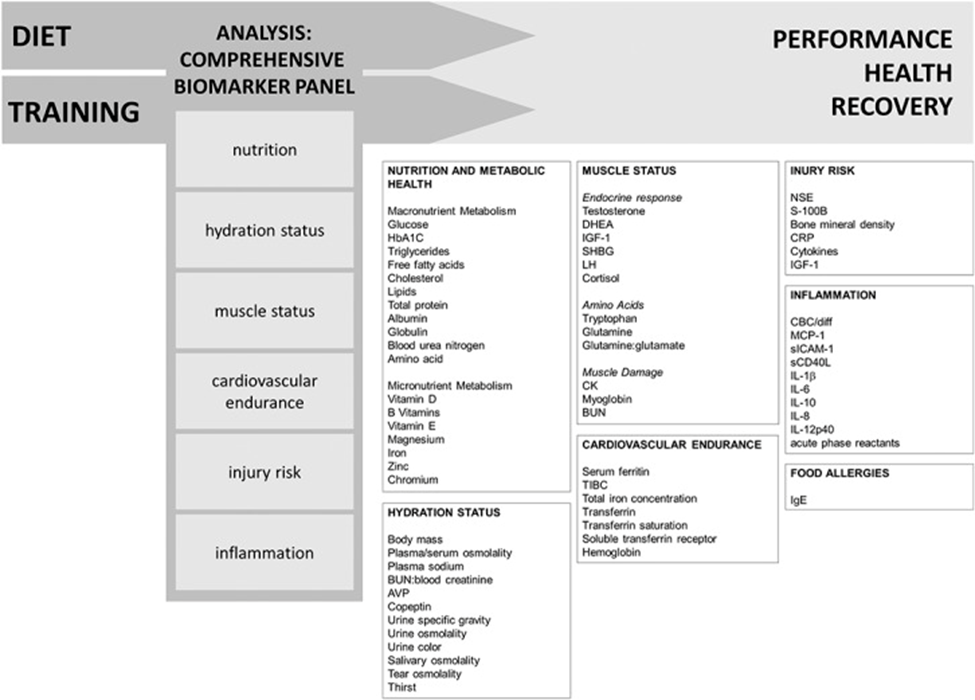A comprehensive baseline analysis would be warranted and then specific biomarkers could be monitored regularly over time. The adage of “first do no harm” applies here as excess exercise can actually cause oxidative stress and unwanted muscle damage.
According to Lee et al. 2017,
A comprehensive performance set of biomarkers should include key markers of (a) nutrition and metabolic health, (b) hydration status, (c) muscle status, (d) endurance performance, (e) injury status and risk, and (f) inflammation.

Lee, Elaine C et al. “Biomarkers in Sports and Exercise: Tracking Health, Performance, and Recovery in Athletes.” Journal of strength and conditioning research vol. 31,10 (2017): 2920-2937. doi:10.1519/JSC.0000000000002122 https://www.ncbi.nlm.nih.gov/pmc/articles/pmid/28737585/ This is an open-access article distributed under the terms of the Creative Commons Attribution-Non Commercial-No Derivatives License 4.0 (CCBY-NC-ND),
Some labs may have panels already created for use by bodybuilders though you may want to personalize them for each client. For example:
CBC with Differential/Platelet Count
Comprehensive Metabolic Panel
Cortisol
Creatine kinase isoforms
DHEA
Estradiol
Ferritin
FSH and LH
Growth Hormone, Serum
Inflammatory markers
Insulin
Lipid panel
Progesterone
Testosterone, Total and free
Thyroid panel
Oxidative stress markers
Vitamin and mineral panels
Please review the ODX Research blog re: Biomarker changes seen in high-performance athletes: https://www.optimaldx.com/blog/biomarker-changes-seen-in-high-performance-athletes
When training for hypertrophy, getting enough protein is important, especially if eliminating high-quality animal-based proteins altogether. You’ll need at least 1.3-2g/kg to maintain and build muscle. Ordinarily, intense exercise can increase serum creatinine due to increased muscle breakdown. Since serum creatinine reflects muscle mass, lower levels could reflect increased breakdown without needed replenishment from dietary protein (Samra 2012).
References
Lee, Elaine C et al. “Biomarkers in Sports and Exercise: Tracking Health, Performance, and Recovery in Athletes.” Journal of strength and conditioning research vol. 31,10 (2017): 2920-2937. doi:10.1519/JSC.0000000000002122 https://www.ncbi.nlm.nih.gov/pmc/articles/pmid/28737585/
Samra, Manpreet, and Antoine C Abcar. “False estimates of elevated creatinine.” The Permanente journal vol. 16,2 (2012): 51-2. doi:10.7812/tpp/11-121 https://www.ncbi.nlm.nih.gov/pmc/articles/pmid/22745616/
Additional reading:
Brouns, Fred et al. “Functional foods and food supplements for athletes: from myths to benefit claims substantiation through the study of selected biomarkers.” The British journal of nutrition vol. 88 Suppl 2 (2002): S177-86. doi:10.1079/BJN2002683 https://scholar.google.com/scholar?output=instlink&q=info:4B1jNzYU8kYJ:scholar.google.com/&hl=en&as_sdt=0,10&scillfp=14974468081361847154&oi=lle
Fett, Waléria Christiane Rezende, et al. "Blood Biochemical Markers of Competitive Bodybuilding Athletes Users of Anabolic Androgenic Steroids and/or Growth Hormone (AAS/GH), Strength Athletes Drugs Free and Sedentary Persons." Strength Athletes Drugs Free and Sedentary Persons (2018). http://article.sapub.org/10.5923.j.sports.20180801.01.html
Nobari, Hadi et al. “Exploring the Effects of Energy Constraints on Performance, Body Composition, Endocrinological/Hematological Biomarkers, and Immune System among Athletes: An Overview of the Fasting State.” Nutrients vol. 14,15 3197. 4 Aug. 2022, doi:10.3390/nu14153197 https://www.ncbi.nlm.nih.gov/pmc/articles/pmid/35956373/
Saeedian, Hossein, Bahram Abedi, and Hoseyn Fatolahi. "Acute Response of Oxidative Stress and Muscle Damage Biomarkers to a Single Bout of Combined Training (Resistance-Aerobic) With Different Intensities Following Q10 Supplementation." Journal of Nutrition, Fasting and Health 10.1 (2022): 71-78. https://jnfh.mums.ac.ir/index.php/50-slideshow/journal/images/journal/article_19665_24f7c9a83121696327a292f14c616dd7.pdf
Schoenfeld, Brad J et al. “Alterations in Body Composition, Resting Metabolic Rate, Muscular Strength, and Eating Behavior in Response to Natural Bodybuilding Competition Preparation: A Case Study.” Journal of strength and conditioning research vol. 34,11 (2020): 3124-3138. doi:10.1519/JSC.0000000000003816 https://pubmed.ncbi.nlm.nih.gov/33105363/
Tidmas, Victoria et al. “Nutritional and Non-Nutritional Strategies in Bodybuilding: Impact on Kidney Function.” International journal of environmental research and public health vol. 19,7 4288. 3 Apr. 2022, doi:10.3390/ijerph19074288 https://www.ncbi.nlm.nih.gov/pmc/articles/pmid/35409969/
